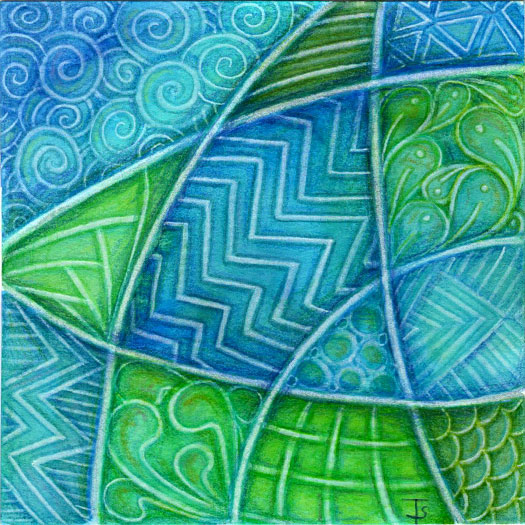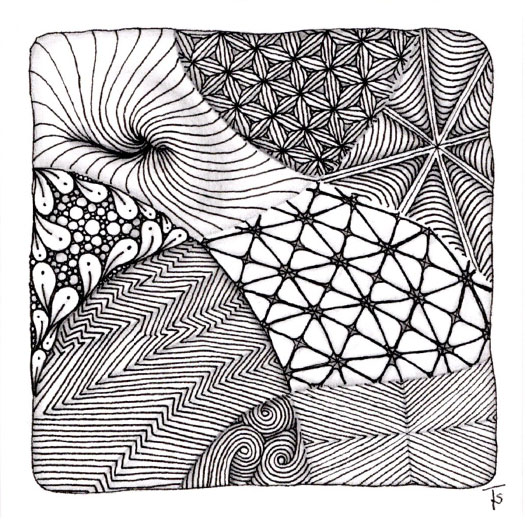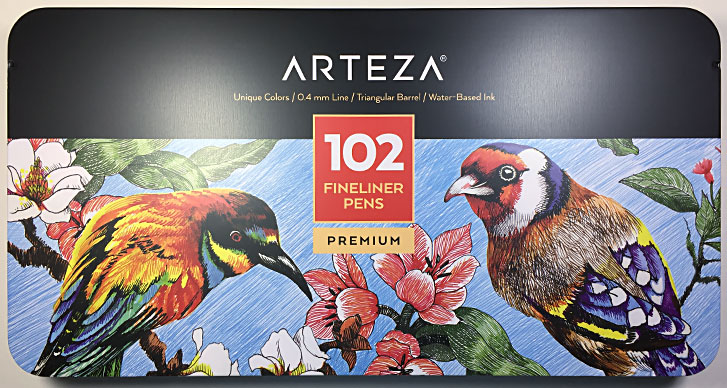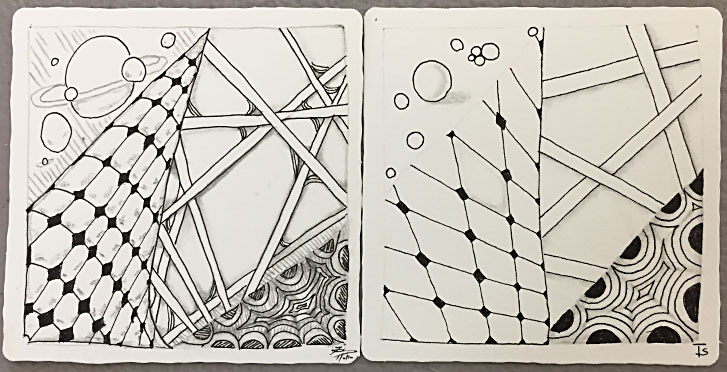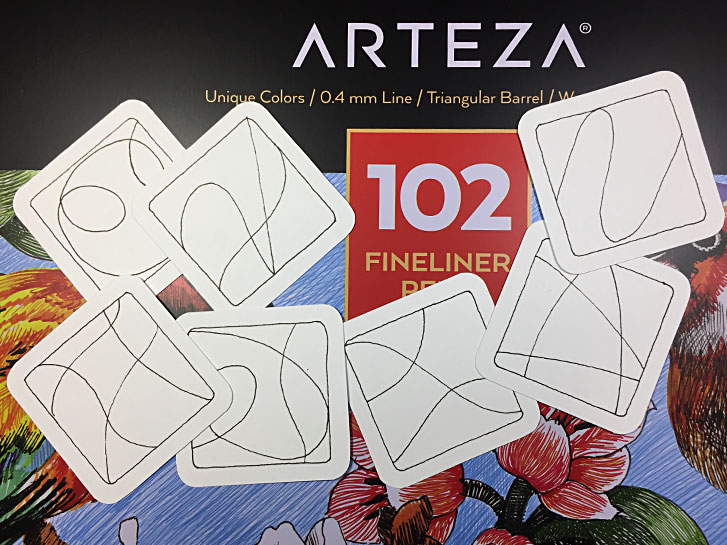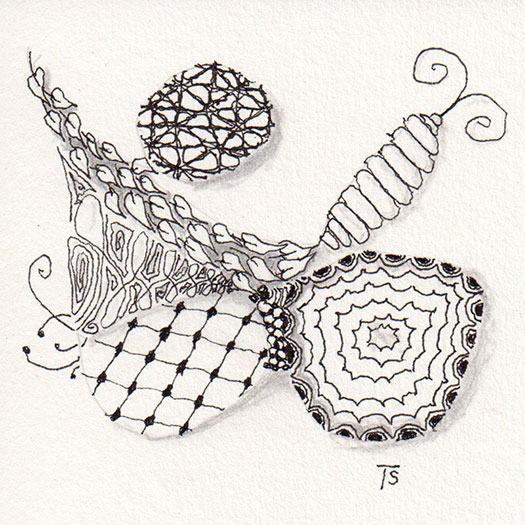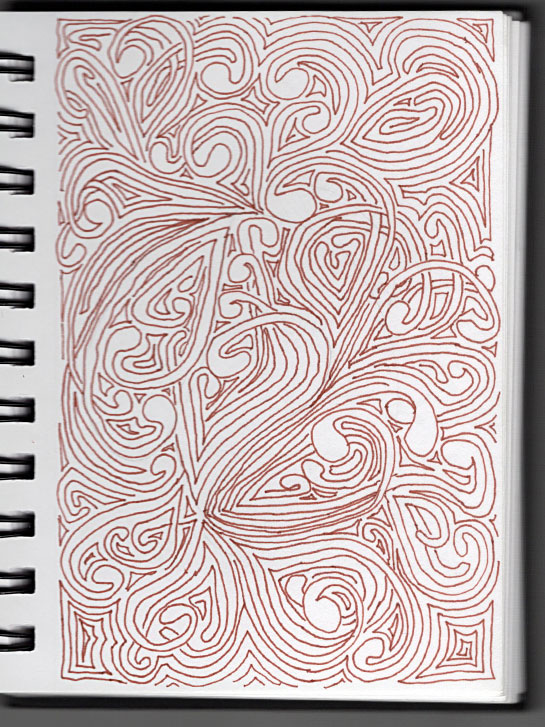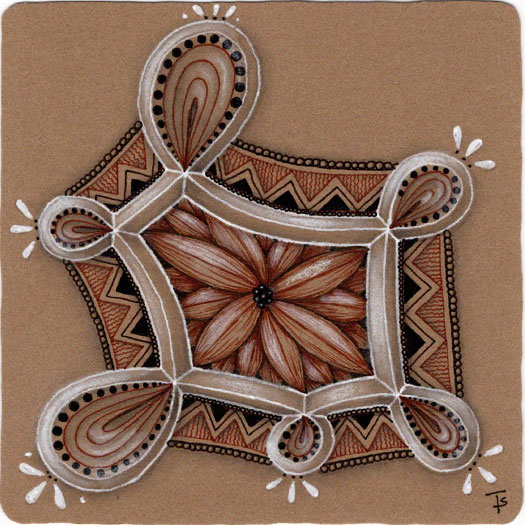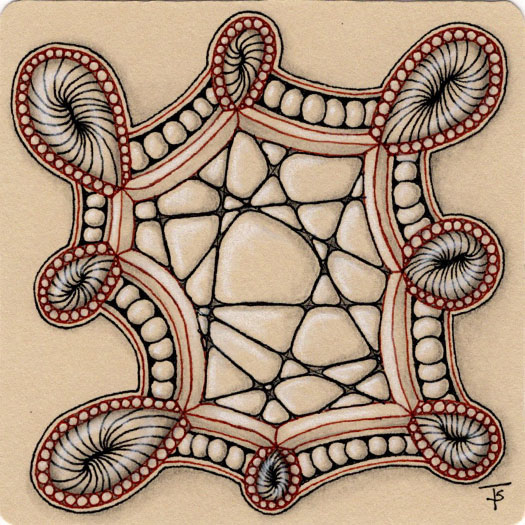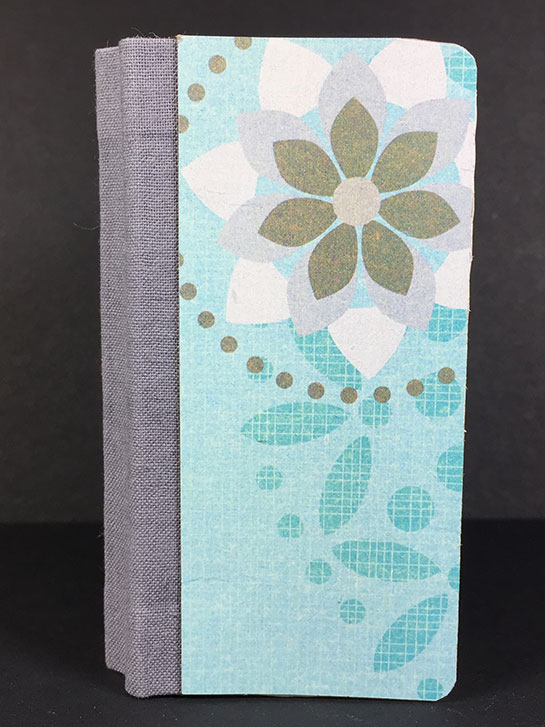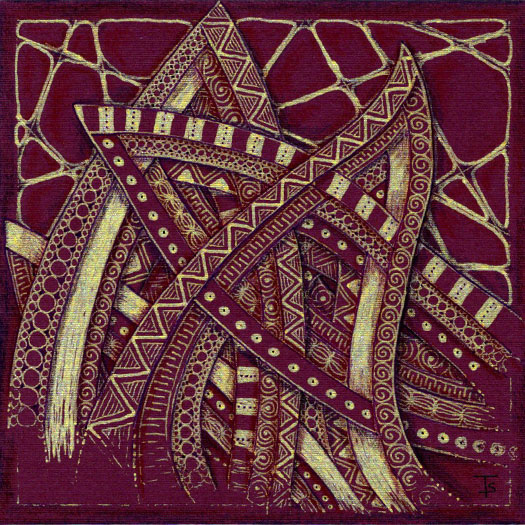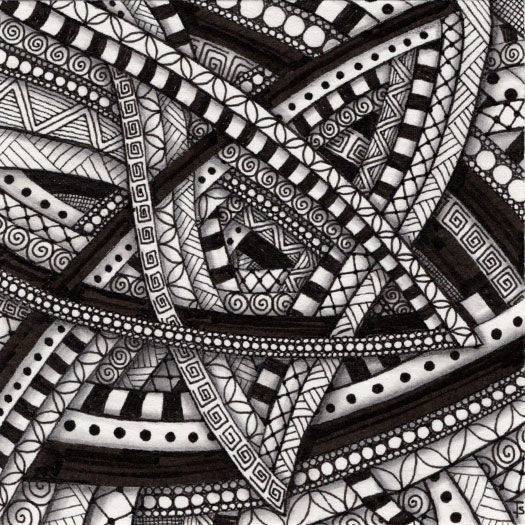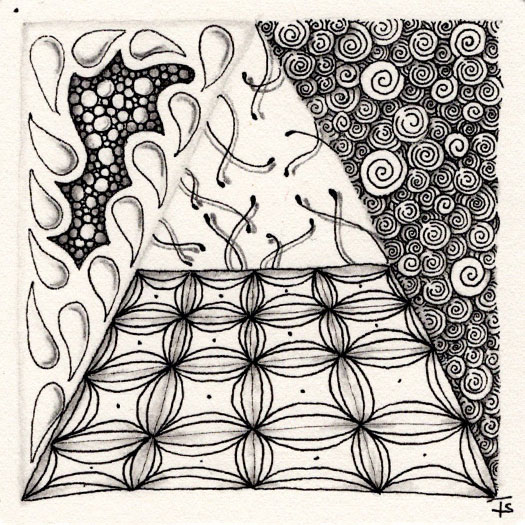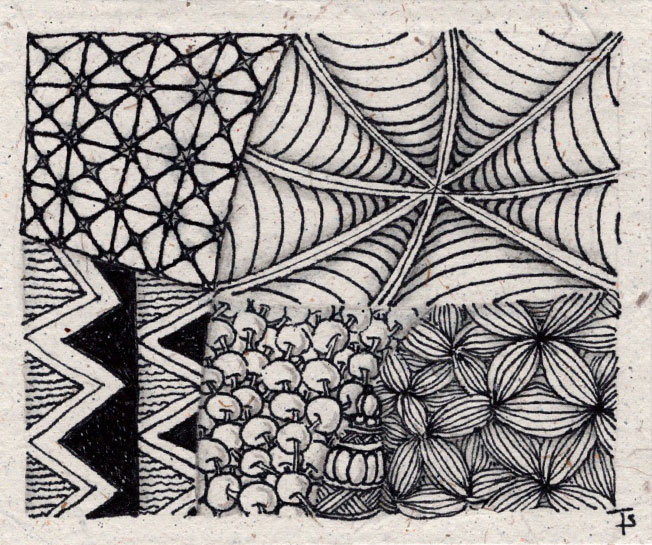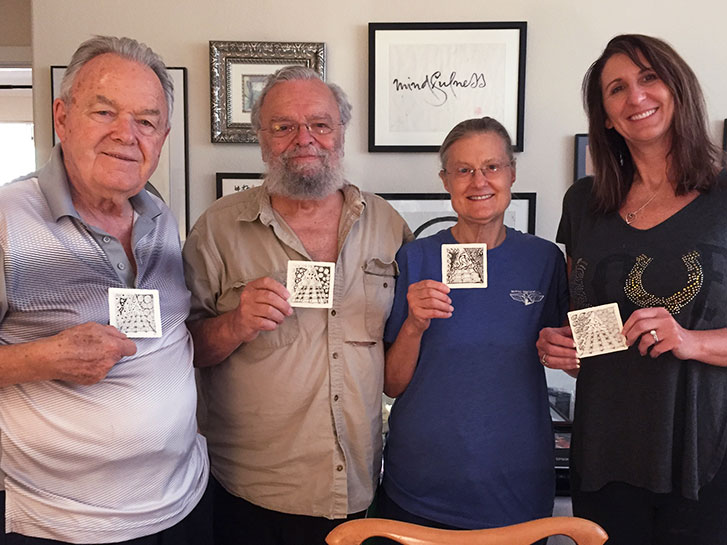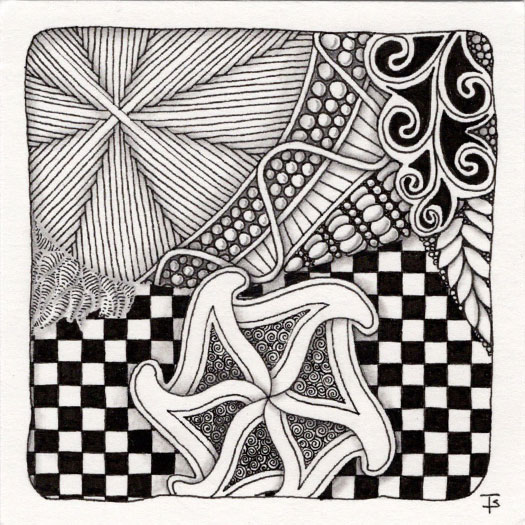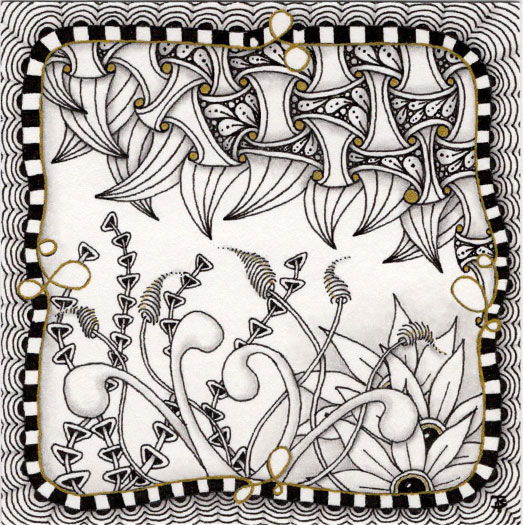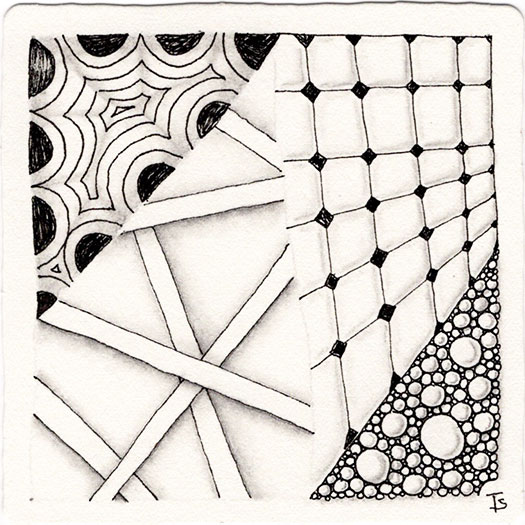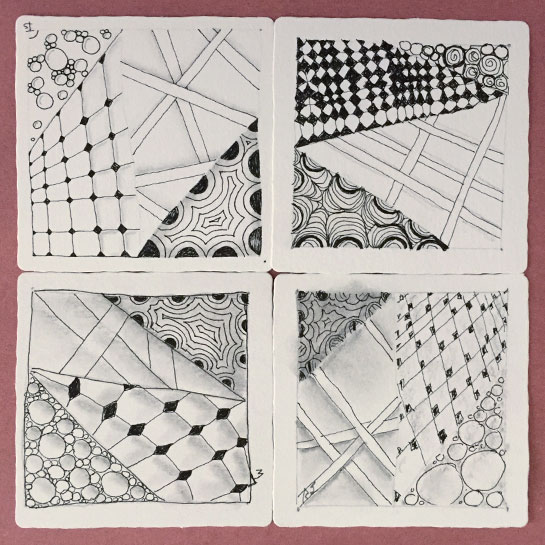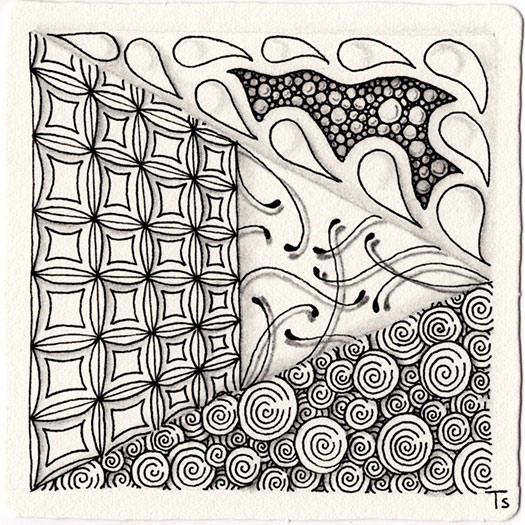This tile was created following the instructions from Eni Oken ’s Art Club ’s latest lesson, Glazed Whitework .
It all started with a watercolor tile. It was an interesting challenge to draw the string and all of the tangles using a white colored pencil. Then more color was added creating the depth and shading you see here.
One of the most challenging things was to select appropriate tangles. It’s much more difficult to create detail with colored pencils than if you were using an inking pen.
My random tanglizer spit out a lot of tangles for practicing line work yesterday. At first, I was a bit worried that these wouldn’t produce enough contrast. But after using my magic wand (actually, a pencil), I like the way they became distinct and unique!
Zentangle drawn on Strathmore Vellum Bristol using a black, Micron pen. Shading done with graphite pencil.
Tangles: Fassett Flux Fracas Nzepple Sand Swirl Static Tipple Xircus
I mentioned, in a post last week , that I would do a review of the Arteza 0.4 fineliner pens. Here it is!
Note: this is not a paid review. This product was purchased from Amazon and not provided by Arteza for review.
I purchased this set of pens from Amazon along with a couple of other things. They arrived in a large box, with another box containing the pens inside. The pens, themselves, come packed in a very nice, hinged tin, as you can see in the image above.
I had a private class with a very artistic, imaginative young lady on Saturday. She wanted to know what the Zentangle method was, so we sat together and I taught the Basic Beginner’s Class.
She was so much fun to work with because she is already a gifted artist and has an inherent understanding of things like drawing behind, line weight, shading, and auras!
As I was showing her the way we do things in Zentangle, she was showing me how she does similar things. I learned a lot from her, and about her, and I’m looking forward to working with her again in the future!
Yesterday, I spent the morning with a group of friends who are also artists. While we chatted, each of us worked on our own projects.
My project was to transfer some pictures of strings that I drew several years ago to bijou-sized tiles. I keep these in the front section of my bijou tangle index.
Generally, when I tangle, I don’t have any problem creating a string. However, once in a while, I just want to push the easy button, and I will pick one of these little string examples and go with that.
How do you challenge yourself? As an artist I’m always looking for different things to try as ways to grow and expand my skills.
Here, this tile was drawn entirely with my left hand. I even signed and dated the back with my left hand.
Why?
Well, first of all, I wanted to see if I could. In addition, drawing with your non-dominant hand builds new neural pathways in your brain. It also challenges you to look at things in a different way, and helps you to understand how your students, those that use a differnt hand to draw, are challenged to follow your instructions!
This fabulous monotangle of Mooka was created by my Mother-in-Law, Twyla Baker.
As many of you already know, she passed away on June 27th. I am in the process of going through her artwork. I found a small, spiral-bound sketch book which contained many Zentangles.
Towards the end of the book, I found this monotangle of Mooka. It fills the entire 4-inch by 6-inch page! I’ve never seen this before and there is no date on it. Because the dates on other pages jump around and are not in consecutive order, I’m not sure when this was done. It was probably some time around 2013-2015.
Another DingsplatZ today! I’ve discovered that about 3 tangles, along with some perfs and dots works well for creating these! My favorite part, though, is the shading. It amazes me how much life it adds to the pen lines!
Zentangle drawn on kraft colored Stonehenge multi using black, sepia and brown, Micron pens and white gel pen. Shading done with graphite pencil and white charcoal pencil.
Tangles: Antidot Knase Ravel
I decided to give dingsplatZ a try this weekend. It was fun to do this on the fawn colored paper. It allowed me to add both highlights and shadows!
Zentangle drawn on fawn colored, Stonehenge Multi using a black and brown, Micron pens. Shading done with graphite pencil and white charcoal pencil.
Tangles: Crazy 'Nzepple Perfs Scena
A couple of weeks ago, I posted about using the tutorial from Chris Titus to create a book of Zentangle tiles.
These little books are made from folded Zentangle tiles. The instructions are very easy to follow, mostly pictures, and produce a very nice book. The tiles are arranged in such a way that they will open out flat, making it easy to tangle on them.
Above you can see the front cover of my book. Honestly, I “cheated”. Instead of covering the board with fabric, I cut the piece from a tag board kleenex box. I liked the design on it, so I just glued it on as it was.
Finally, a gold and maroon tile from Eni Oken's Crazy Gold Auraknot lesson.
While I liked the idea of this, it turned out harder to do than it looked. I found that the widest marking gold pen that I had was kind of sketchy when used to fill in the solid ribbons. On the other hand, I found one with a very fine line that I liked along for creating the patterned details.
Another tile from Eni Oken's Crazy Gold Auraknot lesson!
I am making progress with the lesson. Here, I’ve added the designs to the stripes of the tangle. I stuck with the black and white because I just wanted to get a feel for how to do it.
I’ll finally be using metallic ink on the next one!
Zentangle drawn on Strathmore Vellum Bristol using a black, Micron pen. Shading done with graphite pencil, colored pencil and copic markers.
Another Beginner’s class tile #2! A fascinating thing about the Zentangle method is that no matter how many times you draw a particular tile, it will always be slightly different!
Zentangle drawn on an Official Zentangle tile using a black, Micron pen. Shading done with graphite pencil.
Tangles: Bales Ennies Fescu Printemps
I recently visited Holland, Michigan for a little R-and-R with my husband and older daughter. We decided to walk the main, downtown shopping area, looking in various stores.
We came across The Bridge , a store that specializes in unique, fair trade, import items. There were some very interesting things in the store, but the most fascinating to me was paper made from elephant dung!
I purchased both a small, spiral-bound book and a box of small, loose sheets .
This is my Tuesday morning Zentangle meditation class. These people are so wonderful to be with! They love learning, tangling and each other which makes being with them a total joy.
This week, they used an “A” shaped string and learned Bales, Ennies, Fescu and Printemps. The two tiles (one unfinished) in the lower right are mine.
I love how each of them is not afraid to try whatever variation they think of. They are adventurous spirits who are fearless students!
She had traveled down the hall of the long good bye for such a long time. She slept and awoke and walked towards the door in the House of Waiting. The vastness pulled at her spirit and she longed to be free. She would not miss anything here. She had completed her mission. She would leave it all behind.
It had been her life. But now, she was free to fly.
This tile is the result of an ongoing challenge (#TangleTagCZT30) on the Zentangle Mosaic app . Each person is to create a tile using all of the tangles that came from previous CZTs in the chain, and add one more of their own choosing.
There were seven people in the chain when I was tagged. I’ve added the eighth tangle, Zailz.
I found this interesting, and very challenging. This was a lot of different tangles to try and fit on a single Zentangle and still have anything that wasn’t total chaos!
This is my finished tile from the Tuesday Beginner’s Class. I rarely finish my tile during the sessions because I’m busy helping the students. However, I do always finish them eventually. I don’t mind having many tiles with the same design.
I can always create my own, personal mosaic!
Zentangle drawn on a white, Official Zentangle tile using a black, Micron pen. Shading done with graphite pencil.
Tangles: Bales Florz Hollibaugh Tipple
